We’ll begin our deep dive into the Dark Souls TRPG by looking at the player-focused first half of the book. Part two will cover the game master focused latter half. Designed by Hironori Katou and
published by Group SNE, Dark Souls TRPG is a book that has been sitting in my blog backlog since it was published. It’s a crunchy, class and level based system that seeks to evoke the feeling Dark Souls III, while also avoiding what would be tedious in an analog game. As with many Japanese TRPGs, it only uses six sided dice.
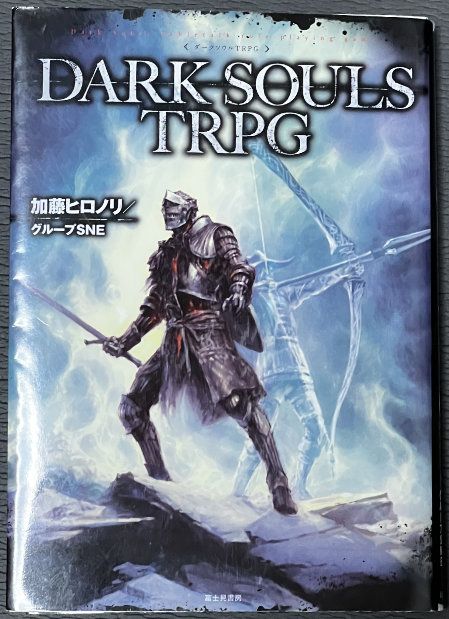 First, for some background. I’ve played and enjoyed Demon’s Souls, so am familiar with the general themes and difficulty, but I haven’t played any of the Dark Souls games. Where possible, I’ve tried to use the official translations for terms, but there are likely differences.
First, for some background. I’ve played and enjoyed Demon’s Souls, so am familiar with the general themes and difficulty, but I haven’t played any of the Dark Souls games. Where possible, I’ve tried to use the official translations for terms, but there are likely differences.
The Physical
The book itself is a 303 page soft cover with jacket that costs ¥1,400. It is B6 (128mm × 182mm) in size, making it the same size as most manga. The first four pages are in color on glossy paper, but the rest are black and white. Illustrations are primarily renders from the game, but there are a few pages of manga by Some Nishiura, and a spattering of original artwork.
The Content
The table of contents outlines eight sections. We’ll take a look at the first four in this post, with the rest coming in part 2.
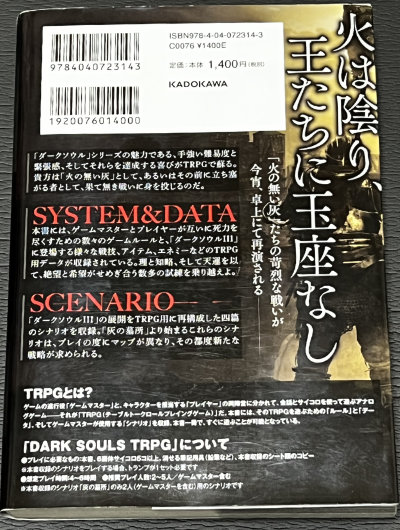 Forward – p.3
Forward – p.3- Character Creation – p.13
- Core Rules – p.63
- Firelink Shrine – p.99
- Scenario – p.131
- Enemies – p.249
- Charts and Sheets – p.292
- Index – p.301
Forward
A single page introduces Dark Souls, TRPGs, and the combination of the two. It then jumps right into how to get started playing. The language is succinct, yet covers the process of playing, including setup and timing, step-by-step. The focus is on concrete action items for how to play, such as selecting a venue and sharing responsibilities for preparation. The flow of a session is:

- Prepare for the session (before game day)
- Prepare the scenario (before game day)
- Character making and leveling (game day)
- One to two hours is estimated for custom characters, but it can be shortened by using sample characters.
- Character introductions (game day)
- Begin the scenario (game day)
- End the session (game day)
- This includes a suggestion to discuss highlights of the session.
The expectations for players and the GMs are also explained, as is how to handle rounding and negative numbers. Next comes the lexicon, with a focus on the dice notations used in the text, as well common terms like PC and GM.
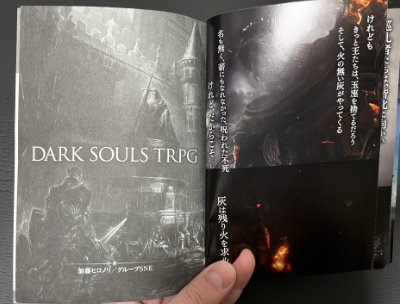
The forward ends with five pages of setting details, each page being half text and half image. Narrated in second person, it starts with you awakening from death without memories, and then instinctively realizing you know how to fight, and indeed, exist for battle.
You are an Unkindled One (火の無い灰), and there are others like you that can be summoned from their own realms. Some are beneficial White Phantoms (白霊) that aid, while others are Red Invaders (赤い侵略者) that seek to plunder the souls you collect.
Character Creation
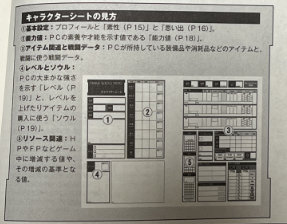
Players have two options for creating a character: customize a sample character or create one from scratch. The character sheet contains lots of columns with numbers that are computed during creation. In a sense, the character sheet is a worksheet that guides you through the math.
The book clearly explains each section of the character sheet, annotating a small version of it. These annotated diagrams occur throughout the book as new concepts and data are introduced.
Memories

A unique addition that the TRPG makes is memories. The goal for adding memories is twofold: one, having a finite number of lives creates tension, and two, it helps provide hooks for role-playing the character.
Each character has three memories, one from a class-specific list and two from lists shared by all classes. Players may select memories by rolling or choosing from the lists. Each class has six memories specific to it, while there are six categories of shared memories, each with a table of six options. The categories are emotional themes, such as “anger” or “joy.” The Warrior memory chart, for example, has the “Day of Liberation” memory: “One day, you were freed from a monastery or boarding house.”
Each time a character dies, a memory is lost. When all memories have been lost, the character’s existence comes to an end and the player creates a new character.
Classes
There are ten classes to choose from, each with a sample character and pre-filled character sheet:
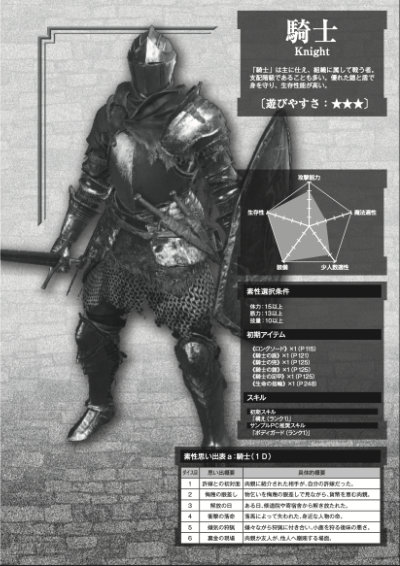
- Knight (騎士)
- Mercenary (傭兵)
- Warrior (戦士)
- Herald (伝令)
- Thief (盗人)
- Assassin (刺客)
- Sorcerer (魔術師)
- Pyromancer (呪術師)
- Cleric (聖職者)
- Deprived (持たざる者)
Each class has a brief description; ease of play rating; spider graph showing its strengths; minimum attributes required to choose the class; starting items; starting skills; and a list of memories. There’s also a recommended skill to choose when leveling up the character. The sample characters start at level nine, and an additional skill is gained at level ten, so the player will get to choose a new skill early on. Also, each scenario has a recommended level range, so it’s possible to start the sample character at a higher level.
Taking the Knight class as an example, its ease to play is three out of three stars. Its spider graph shows it as having great survivability and equipment, and a decent attack power and suitability for small groups. However, the magic ability is middling at best.
Each starting item has a handy page number for the detailed item listing. Further simplifying things, each sample character sheet is prefilled with most of the crunchy bits needed to play.
PDF character sheets for all of the sample characters are available on the official support website.
Attributes

Characters have eight attributes:
- Vigor (生命力)
- Attunement (集中力)
- Vitality (体力)
- Strength (筋力)
- Dexterity (技量)
- Intelligence (理力)
- Faith (信仰)
- Luck (運)
The character sheet has three columns per attribute: starting, gained, and total (starting + gained) values. There is a small box for the modifier in the total column. The modifier is calculated by dividing the total by four.
Combinations of the above stats are used to derive three resources: Hit Points (HP), Focus Points (FP), and Luck. Everyone starts with four Estus Flasks, which recover HP and FP.
Choosing a Sample Character
Choosing a sample character is simple, with only a few decisions needed: class, name, age, and gender. The sample Knight has the “Bodyguard”, “Stance”, “Backstab”, and “Parry” skills listed, but only starts with a rank in “Stance”. Depending on the level, additional skill ranks may be purchased. The recommended skill for the next level is “Bodyguard”. We’ll discuss skills in more detail later.
Creating a custom character
For custom characters, the player rolls 2D6+4 eight times. If the total of these rolls is less than eighty-one, the player re-rolls until they’re eighty-one or greater. There’s also a static point buy of eighty-eight points. Either way, the player then freely assigns these to their stats. A sidebar also recommends re-rolling if the total is 105 or higher because the character may be too strong.
Each class has attribute requirements that must be met in order to choose it. In order to become a Knight, a character must have 15+ Vitality, 13+ Strength, and 10+ Agility. Skills are also chosen at this point, but we’ll look at how skills work later.
In total, thirty-nine pages are devoted to the classes and sample characters. Before heading into the rules section, it closes with a detailed explanation of how to do random selection using a d6.
Core Rules
This chapter starts with a surprise– players decide on a single host player character, and the others become White Phantoms that can be summoned. Furthermore, there’s an optional rule to capture the mood of the video game: only the host PC can speak. Using this rule, the summoned characters can only communicate through gestures, and there’s even a two page chart of gestures (PDF) that can be referenced. This applies only to character communication– the players themselves should speak normally for game mechanics and to describe what they’re doing.
It also immediately explains how death works in the game, which seems very apropos for a Dark souls game. Importantly, if the host PC dies, White Phantoms are sent back to their own worlds and the PC resurrects at the Fire Keeper. When a White Phantom dies, they return to their world where they wrote their summoning sign. Either way, all resources are replenished. Each death causes a random memory to be lost, and when all memories are lost, so too is the character.
Resources
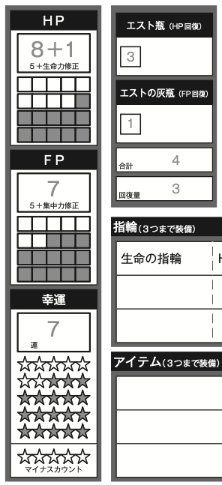
Each character has the following resources to manage:
- HP (Hit Points) – a character dies when this reaches 0.
- FP (Focus Points) – used to power magic and skills.
- Luck – used for re-rolling dice and finding items when looting an enemy.
- Estus Flask – replenishes Hit Points.
- Ashen Estus Flask – replenishes Focus Points.
HP and FP are represented by boxes that are checked or unchecked to indicate the current value. Each player has four flasks that can be allocated between Estus Flasks and Ashen Estus Flasks. Scenarios may increase or decrease the amount of HP or FP a flask heals, but the default is three HP or FP.
All of the above resources are replenished by visiting a lit Bonfire (篝火).
Action Checks
The success or failure of actions is determined by following six steps. First, the GM decides that a check is necessary. Next, whether it is an active or passive check. Active checks can drain FP, while passive checks do not. For the third step, the GM determines the attribute to be used, and then in the fourth step, sets a target number. Players then declare who is making the check. Finally, the players roll 2D6 and add the modifier for the appropriate attribute. If the result is equal to or greater than the target number, the check succeeds. If not, it fails. With active checks, the player must expend an FP for each die result of one.
With the basic rules for checks out of the way, this section details how each attribute can be used before going into the specifics of combat.
Combat
Combat is involved and the rules create activity for both the attacker and defender. Similar to the video game, managing Stamina is a key component. Positioning is abstracted into two types locations: the main battle area and up to five safe areas. There are no ranges, meaning all characters are in range of all attacks unless they are in a safe area. Safe areas may only be used once, and once used, cannot be used again. A character can remain in the safe area until the start of the next turn, after which they automatically return to the battle area.
There are two short manga by Some Nishiura included to help explain combat that the publisher has also posted to Twitter.
明日発売の「DARK SOULS TRPG」より、にしうら染(@_some)先生が描く戦闘ルール解説コミックをご紹介します!
「どんなルールか気になる」という方や、「この土日にちょっとセッション予定なんだよね」という方はぜひご一読ください! pic.twitter.com/lFktGgB2UO
— 富士見ドラゴンブック編集部 (@dragonbook_game) May 19, 2017
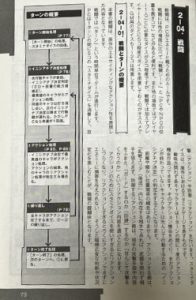
Combat is built around two loops that repeat until combat is over:
- Start of turn
- Determine initiative
- Action resolution
- End of turn
Steps two and three repeat until all characters have gone. Once step four completes, combat returns to the first step and a new turn begins.
Initiative
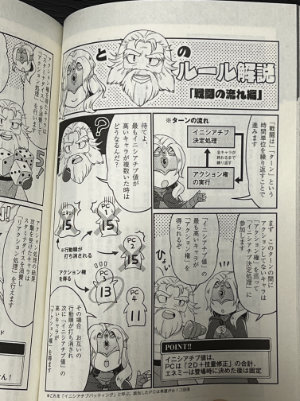
Many games break structured time into rounds consisting of turns. In contrast, there are only turns in Dark Souls. Within a turn, players who have not yet acted roll initiative. The character with the highest initiative is able to act, after which the remaining players roll initiative again. This continues until everyone has acted, at which point a new turn begins. To streamline this process, enemies only once at the start of combat. Characters with the same initiative interfere with each other, cancelling both of their initiative rolls. As consolation, players whose role is canceled receive one point of Luck.
Stamina
Every PC has pool of five stamina dice. These are used for both actions and reactions, so managing one’s stamina is important. Using all of your stamina to attack leaves your unable to defend. Stamina dice are refreshed at the start of each turn.
Actions
When a PC is able to act, they declare how many stamina dice they’re using for actions and then roll them. These dice become action dice that are spent to perform actions. A character can perform any number of actions so long as they spend the required action dice. Stamina dice used to act cannot be used to react.
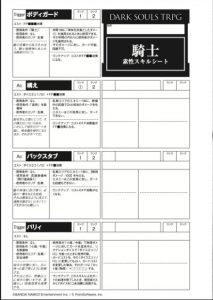
Many actions, including attacking with a weapon, require a target number to be exceeding by adding the results of one or more dice together. Simpler actions just require a number of action dice regardless of result. The more powerful actions require doubles (or even triples) in order to be used. In the case of skills, each indicates the cost to activate it and any resources (such as FP) that must be expended.
Returning to the sample Knight, the Stance skill requires spending two action dice with the same number and two FP in order to activate. It deals damage equal to the two-hit value of the weapon and cannot be guarded against when activated. The Backstab skill requires three action dice with the same number, but only one FP. In contrast, moving between areas costs two action dice of any value.
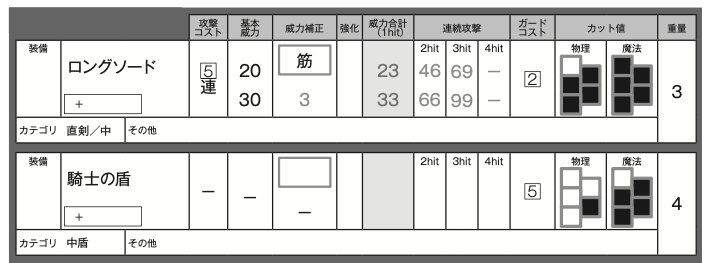
Weapons have a cost to attack, which is denoted in the third column from the left. In this case, the 5 in the box indicates action dice totaling five are needed to attack. Some weapons have a “chain” attribute (連) that means multiple attacks can be chained together for increased damage. Chaining an attack is an action that costs one more stamina than the previous attack.
For example, the longsword costs five stamina to attack with, and attacks can be chained. To hit with one attack requires one or more action dice that total five or more. To chain a second attack, the stamina cost is increased to six, but the damage is doubled from 23 to 46. If the character managed to still have action dice totaling seven or more, a third hit for triple the base damage is done. This increased damage is useful for damaging tough enemies by penetrating their high defense rating.
Reactions
There are two types of reactions that anyone can perform: Guard and Dodge. Skills with a reaction trigger are mentioned, but I haven’t found any in the core book. Guard uses a weapon or shield to deflect the blow and lessen the HP reduced by an attack, while Dodge completely negates the attack and its effects. The difficulty of Guard is based on the equipment used, while the difficulty to Dodge is determined by encumbrance level. Players can only choose one reaction per attack, and must do so before rolling their reaction dice, which are rolled one by one. Dice rolled this way are expended and cannot be used again until the start of the turn.
Damage and Wounding

Any damage not negated by reactions is compared to a wounds chart to determine how much HP, if any, the character loses. Each character has two charts for wounds: one for physical damage and one for magical damage. In both cases, worn armor and the PC level modifier determine defense. Damage between 0 and the character’s defense does not decrease HP. Exceeding that value decreases HP by 1 point for every 10 points of damage exceeding their defense. If the character succeeded on their Guard reaction, the amount of damage is reduced by the guard cut amount of the item. Resistances and weaknesses may also affect the amount of HP decreased.

The sample Knight begins with 9 HP. With a level modifier of 2 and wearing armor that provides 17 defense, they have a total of 19 defense. This means up to 19 points of damage is soaked without decreasing HP; 20 to 29 damage subtracts 1 HP; 30 to 39 damage subtracts 2 HP, and so on, up to losing 7 HP from a single hit.
End of Combat
When combat ends, PCs automatically acquire souls from their vanquished foes. They may also attempt to loot enemies by making a Luck check with the difficulty and lootable items listed in the enemy data. Enemies are grouped together by type, and PCs loot per enemy group. Multiple PCs may attempt to loot the same group, but only a single item is found even if multiple PCs succeed.
Luck
In addition to being used for looting, Luck may be spent to reroll a single die on various checks. Doing so decreases Luck by one.
Souls
Souls are used as both XP to advance the character, as well as currency to purchase items. They are obtained from multiple sources: the scenario, monsters, and selling items.
Items
Characters may carry up to three consumables and wear up to three rings. Items that are readied by the character add weight, which affects the difficulty to dodge attacks. Characters in lighter armor will favor dodge reactions, while those wearing heavy armor will likely opt to guard.
Firelink Shrine
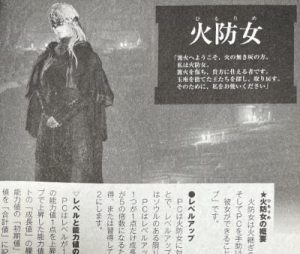
The Firelink Shrine section begins on page ninety-nine and continues for thirty-one pages. This section introduces the NPCs that reside there and the services they offer.
The NPCs are:
- Firekeeper – provides leveling up and acquisition of skills.
- Handmaiden – handles buying and selling of items.
- Blacksmith Andre – strengthens weapons using souls, as well as modify the ratio of Estus and Ashen Estus Flasks.
- Ludleth of Courland – provides soul transposition, which players unlock in the third scenario. A small number of weapons and rings are craftable only by soul transposition.
Of these, we’ll look at the Firekeeper and Handmaiden sections in more detail.
Firekeeper and Advancement
The first part of the Firekeeper section deals with leveling up. Leveling up costs 100 times the next level in souls. Each time a character levels up, they may increase an attribute by one and learn a new skill every five levels.
The rest of this section details the 48 available skills that are divided into five categories: weapons, magic, sorcery, miracles, and other.
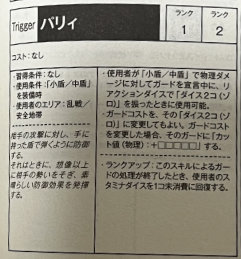
Skills have a timing; skill name; rank; cost; flavor text; prerequisites to learn; requirements to use; effects; and how ranking up a skill affects it. Most skills have two ranks available. The vast majority of skills are Actions, with triggers being the next most common. There are a few passives, and I didn’t see any reaction skills despite the text indicating they can exist.
One skill I found interesting was “Parry”. It has a timing of Trigger, with the condition that the character performed a Guard reaction with a small or medium shield and doubles were rolled. If both conditions are met, the amount of HP lost is reduced by the shield’s physical guard cut value plus five. Having two ranks in this skill causes one of the expended reaction dice to be recovered after the parry occurs.
The Handmaiden’s Items
The Handmaiden’s sections begins with a brief explanation of buying and selling items. Consumables are the first type of item listed, and each has a price; max set size; cost to use; and notes. Items are bought and sold as a set, but many items have a set size of one.
Using Green Blossom as an example, it costs one stamina die to use and increases the 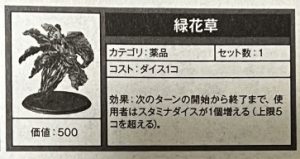 stamina dice pool next turn by one. It has a set size of one, so can only be used once. On the other hand, Throwing Knives have a set size of five. This means they can be used five times while only taking a single item slot. Characters may only have three consumables readied.
stamina dice pool next turn by one. It has a set size of one, so can only be used once. On the other hand, Throwing Knives have a set size of five. This means they can be used five times while only taking a single item slot. Characters may only have three consumables readied.
After consumables, weapons and shields are listed. Both have attribute requirements to use, as well as a category; attack cost and whether multiple attacks can be made; base damage (one handed and two-handed, for certain weapons); associated attribute; guard cost; physical and magical guard cut values; notes, weight, and price.

Most weapons can only be used in the battle area, but bows and crossbows can be used from both battle and safe areas. Missile weapons cannot make multiple strikes, but a “headshot” that deals double damage is possible. The weapon itself provides base damage, with ammunition modifying it and providing additional effects.
In contrast to weapons and shields, armor does not have attribute requirements in order to be worn. Each series of armor has three pieces: head, torso, and leg armor. Some sets give bonuses when all three are equipped. Each item in the set has a physical defense, magical defense, weight, and price.
Behind the Screen
We’re now roughly half way through the book and covered the majority of player content. We’ll look at the GM-portion of the Dark Souls TRPG in part two!
Live Play
There’s a live play in Japanese available on Youtube:
Acquiring
Available at most local game shops in Japan, it’s also available on Amazon in Kindle format.
| Dark Souls TRPG | |
|---|---|
| Time | 4 to 6 hours |
| Players | 2-5 |
| Maker | Group SNE Designer: Hironori Katou |
| Details | Official Site |

